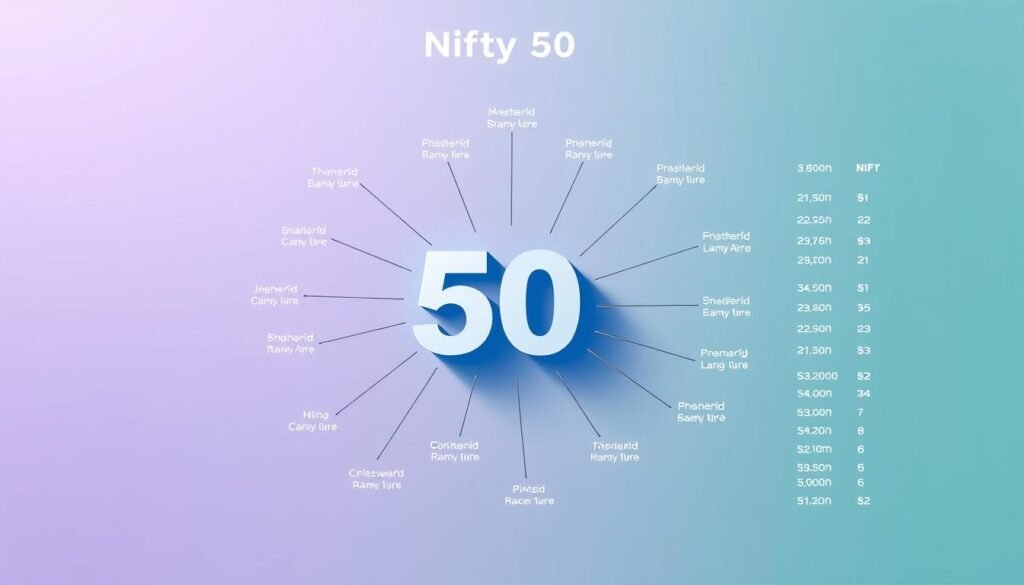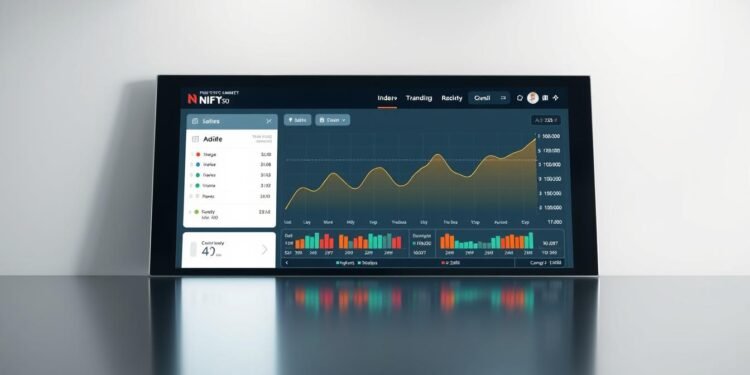What if you could decode the stock market trends to maximize your gains? The Nifty index, India’s benchmark for top-performing stocks, offers a window into the country’s economic health. Currently trading at 25,044.35 INR, it has gained 7.11% year-to-date, showcasing resilience despite market fluctuations.
In September 2024, the index hit an all-time high of 26,277.35 INR, proving its potential for investors. Stocks like Bharti Airtel surged 37.92%, while others like IndusInd Bank lagged with -44.80% losses. This contrast highlights the importance of smart strategies.
Whether you prefer index funds or direct stock picking, timing trades with technical analysis can make a difference. Volatility management is key to long-term success. Let’s explore how to navigate this dynamic market.
Key Takeaways
- The Nifty 50 index reflects India’s economic growth, currently at 25,044.35 INR.
- Year-to-date gains stand at 7.11%, with an all-time high of 26,277.35 INR.
- Top performers like Bharti Airtel (+37.92%) contrast with underperformers like IndusInd Bank (-44.80%).
- Index funds and direct stock picking offer different risk-reward balances.
- Technical analysis and volatility management are crucial for trading success.
What Is the Nifty 50 Index?
The Nifty 50 serves as India’s financial compass, tracking the pulse of its top-performing stocks. This benchmark index represents over 60% of the National Stock Exchange’s free float market cap, offering a snapshot of India’s corporate giants. Updated every six months, it ensures relevance in a dynamic market.

Understanding the Nifty 50’s Composition
Spanning 13 sectors, the index anchors on heavyweights like Reliance Industries (229.56B INR), HDFC Bank (174.57B INR), and TCS (143.92B INR). Financials dominate at 27%, followed by IT (15%) and energy (12%), reflecting India’s economic drivers.
Unlike the S&P 500’s 505 components, the Nifty 50’s 50-stock approach prioritizes concentration over breadth. High-value constituents include Maruti Suzuki (12,611 INR/share) and UltraTech Cement (11,579 INR), showcasing premium market segments.
How the Nifty 50 Reflects the Indian Economy
The index’s quarterly rebalancing adjusts weights based on market cap, ensuring alignment with current valuations. Sector allocations mirror GDP contributions—financials for credit growth, IT for exports, and energy for industrial demand.
Investors use this data to spot trends, like rising IT stocks signaling tech sector resilience. The Nifty 50 isn’t just a list; it’s a live dashboard of India’s economic engine.
Current Nifty 50 Market Trends
June 2025 has been a rollercoaster for India’s benchmark index, with sharp swings driven by global events. The Nifty 50 fluctuated between 25,100 and 25,300 points before closing below 25,000 on June 24, reflecting investor caution.
Recent Performance and Key Movements
A 260-point intraday drop from the day’s high of 25,300 coincided with Middle East ceasefire news. Brent crude fell to $70/barrel, down 18% since the conflict de-escalated, easing inflation fears.

Defensive sectors like healthcare and utilities outperformed during the volatility. Bajaj Finance surged 8.2% month-to-date, while Infosys gained 5.6% post-Q1 results, signaling tech resilience.
Top Gainers and Losers in the Nifty 50
Momentum stocks like Bajaj Finance and Infosys led gains today. Conversely, Kotak Bank fell 12% year-to-date, highlighting risks in overexposed positions.
The Gift Nifty futures hinted at cautious optimism, trading slightly above spot levels. Investors should monitor oil prices and global indices for near-term cues.
Why Nifty 50 Matters for Investors
Investors worldwide track the Nifty 50 as a barometer of India’s economic momentum. This benchmark delivers more than just price movements—it provides a framework for measuring investment success across emerging markets.
Benchmarking and Portfolio Performance
The index has delivered an 11.2% compound annual growth rate over 15 years, outpacing the Sensex’s 10.8%. Such consistency makes it ideal for evaluating active fund managers and ETF performance.
Daily liquidity of $2.1 billion ensures tight spreads for traders. For dollar-based investors, currency gains boosted returns to 9.4% annually when accounting for INR appreciation.
Nifty 50 vs. Other Global Indices
Compared to the Dow Jones‘ 4.3% 2024-2025 gain, the Nifty’s 7.11% rise shows stronger growth potential. Its 22.3 P/E ratio suggests higher earnings expectations than the S&P 500’s 19.8 multiple.
The stock exchange instrument offers diversification with just 0.62 correlation to MSCI Emerging Markets. While the Nikkei 225 sees higher daily volume ($4.8B), the Nifty provides better sector balance for long-term holdings.
Current prices reflect India’s unique position as both a consumption-driven and export-oriented economy. This dual characteristic helps stabilize returns during global market shifts.
How to Trade the Nifty 50 Index
Investors have multiple paths to capitalize on India’s benchmark index movements. Choosing between direct holdings and derivatives depends on risk tolerance and capital availability. Each method offers distinct advantages for tracking price action.
Direct Investment vs. Index Funds
Owning shares directly provides full rights like dividends but requires larger capital. Alternatively, ETFs like Nifty Bees track the index with a low 0.05% fee. Motilal Oswal’s ETF charges 0.07%, while ICICI Prudential’s fund costs 0.15% annually.
Index funds suit passive investors seeking broad exposure. Active trading strategies benefit from stock selection within the index. Compare costs and liquidity before committing funds.
Using Futures and Options for Nifty Trading
Futures contracts offer 25x leverage, with each 75-point move equating to ₹112,500 per contract. Margins start at ₹12,000, making them accessible for short-term trade setups. Monitor expiration dates to avoid rollover fees.

Options provide downside protection—25-delta puts cost 1.2% weekly. Weekly expirations carry assignment risks if held until Friday. Platforms like Zerodha and Upstox streamline order execution on their website interfaces.
Always set stop-loss orders to limit potential loss. Derivatives amplify gains but require understanding the underlying stocks and index behavior. Start with paper trading to test strategies risk-free.
Expert Tips for Nifty 50 Trading Success
Volatility creates opportunity—if you know when and where to strike. Professional traders combine live market data with technical indicators to spot high-probability setups. These methods turn random price swings into calculated moves.

Timing Your Trades for Maximum Gains
68% of intraday gains occur between 9:30-11:30 AM IST. This optimal time window sees peak liquidity and institutional participation. Watch for 30-minute volume surges above the 20-day average to confirm momentum.
The 25,200 level acted as June 2025’s monthly resistance, while 24,800 provided reliable support. Live trades near these zones with 1:2 risk-reward ratios capture trends efficiently. Consumer sector patterns often lead morning rallies.
Leveraging Technical Analysis for Nifty
Fibonacci retracements on 1-hour charts pinpoint reversals. The 61.8% level matched June 24th’s bounce at 24,950. Combine this with RSI divergence—when prices hit new highs but momentum fades—to avoid false breakouts.
A 20 EMA crossover with 1.5x volume triggers signals high-confidence entries. Set profit targets at recent swing highs and trail stops below the 50 EMA. These algo-tested parameters work across all trading hours.
Remember: One disciplined move beats ten reactive trades. Track sector rotation monthly to anticipate shifts in market leadership.
Navigating Market Volatility in Nifty
Global tensions send shockwaves through markets, but savvy investors can turn turbulence into opportunity. The Nifty 50’s 8.2% drop during 2024’s oil price spike proves even stable indices react to geopolitical conflict. Smart positioning transforms these swings into advantage.
Impact of Global Events on Nifty
June 2025 saw defense stocks plunge 4-7% after Donald Trump‘s policy shift on Asian arms deals. Such moves ripple across sectors—IT stocks fell 12% during USD-INR currency conflict last quarter.
Iran-Israel tensions caused similar patterns. When Brent crude hit $90/barrel in 2024, energy stocks surged while autos collapsed. These real estate and industrial impacts show why traders monitor headlines.
Strategies to Mitigate Risk During Volatility
Allocate 25% of your portfolio to Nifty Put options during earnings season. This hedge limits loss when stocks like Kotak Bank swing wildly. Set 2% trailing stops on intraday trades to lock in gains.
Defensive sectors provide stability. The Nifty Pharma Index ETF returned 15% during last year’s Donald Trump tariff announcements. Such moves help portfolios weather storms when the mark turns against you.
Remember: Volatility isn’t risk—it’s the price of opportunity. With the right tools, even Iran-Israel crises become profit channels for prepared traders.
Top Stocks to Watch in the Nifty 50
Smart investors focus on high-potential stocks within the Nifty 50 to maximize returns. The index’s top performers and undervalued gems offer distinct opportunities for growth and income.
High-Performing Nifty Components
Bharti Airtel leads 2025 gains with a 37.92% surge, driven by 5G expansion. Bajaj Finance follows at 29.4%, boasting a 34% ROE and 22% loan book growth.
State Bank of India (SBI) rose 24.7% this year, fueled by rural credit demand. Analysts set a target of ₹1,850 for HDFC Bank, citing stable margins.
Stocks with Growth Potential
Reliance Industries eyes ₹3,200 by Q3 2025, supported by retail and real estate ventures. FIIs accumulated 2.3M ITC shares last month, signaling confidence.
Tata Steel trades at 0.8 P/B ratio, presenting value in metals. L&T’s $2.1B Middle East contracts could drive re-rating. Monitor these points for entry signals.
Conclusion
Mastering the Nifty index requires understanding key levels and strategic timing. The market shows strong resistance at 25,300 and support at 24,500—critical zones for entry and exit.
Focus on sector rotation, especially after RBI policy shifts. Pair trades like long IT with short autos to hedge volatility. Remember, 65% of options traders lose money; stick to risk-defined strategies.
Watch the June 25th FOMC meeting for INR impacts. Use live charts and volume tools to track the close. Smart moves now can lock in gains as the Nifty evolves.
FAQ
What is the Nifty 50 Index?
The Nifty 50 is India’s benchmark stock index, tracking the performance of 50 large-cap companies listed on the National Stock Exchange (NSE). It reflects the overall health of the Indian economy.
How does the Nifty 50 impact investors?
It serves as a key benchmark for portfolio performance. Many mutual funds and ETFs track this index, making it crucial for long-term and passive investors.
Can I trade the Nifty 50 directly?
Yes, through index funds, ETFs, or derivatives like futures and options. Direct stock purchases require buying shares of all 50 companies individually.
What drives Nifty 50 market trends?
Factors include corporate earnings, economic policies, global events (like oil price shifts), and foreign institutional investor activity.
How do futures and options work for Nifty trading?
Futures let you bet on the index’s future price, while options provide the right (not obligation) to buy/sell at a set price. Both are high-risk, high-reward instruments.
Which sectors dominate the Nifty 50?
Financial services, IT, and energy sectors hold the largest weightings, with companies like Reliance Industries and HDFC Bank leading the composition.
How can I reduce risk when trading the Nifty 50?
Diversify across sectors, use stop-loss orders, and monitor global news. Technical analysis tools like moving averages also help identify entry/exit points.
What are the top-performing stocks in the Nifty 50?
Stocks like Tata Consultancy Services (TCS) and Infosys often lead gains, but performance varies quarterly. Check live market data for current leaders.
Does the Nifty 50 correlate with global indices?
Yes, especially during major events (e.g., U.S. Fed rate changes). However, domestic policies and growth trends also heavily influence its movement.






